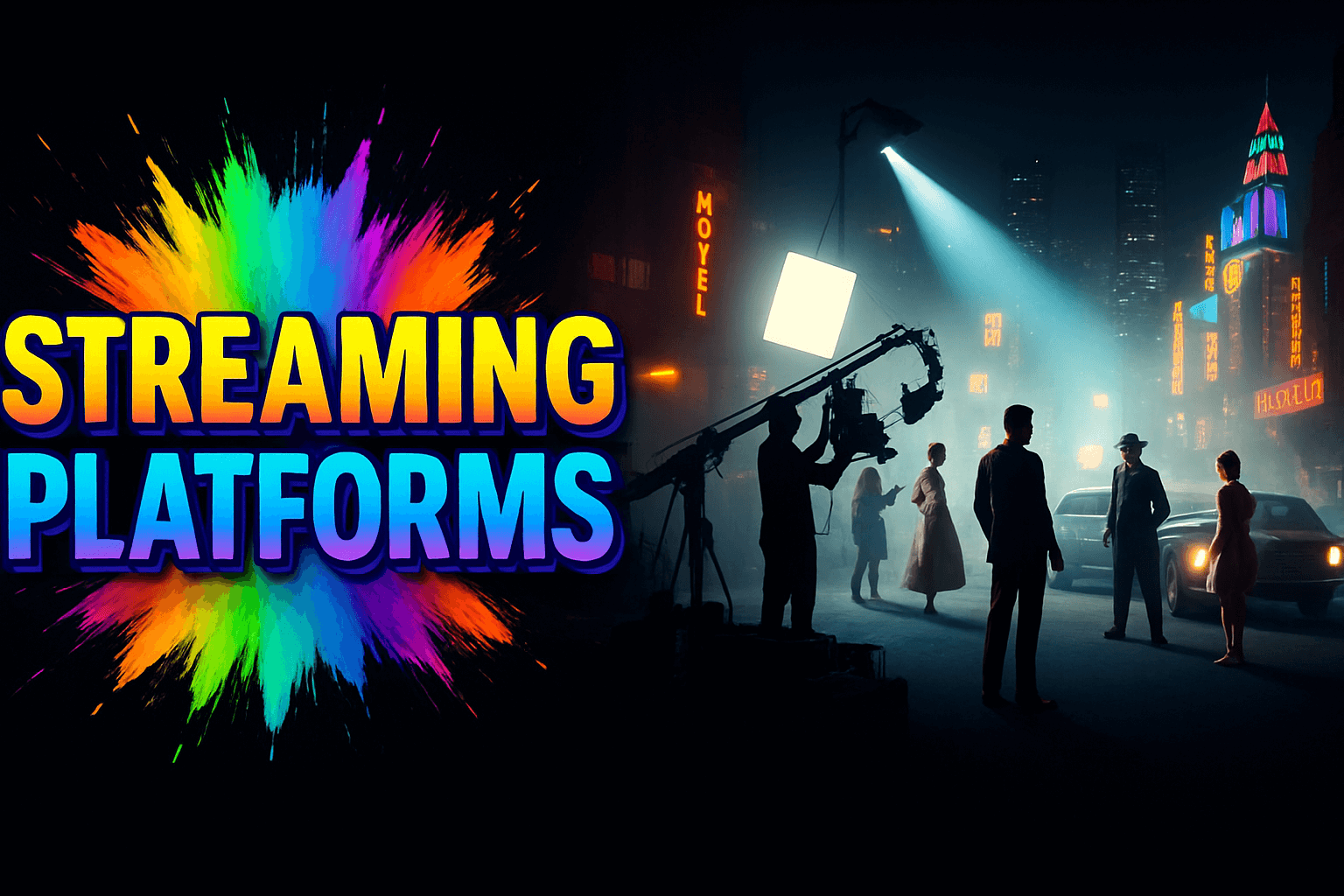Navigating the Ecosystem of Global Streaming Platforms, Content Buyers: A Strategic Guide for Producers

Introduction
The global Media & Entertainment (M&E) landscape has undergone a foundational, non-negotiable shift: the traditional buyer-seller relationship has dissolved and been replaced by a complex, data-driven partnership model.
For producers and content creators, securing financing and distribution no longer means navigating a handful of broadcasters, but engaging a dynamic ecosystem of streaming platforms, content buyers, and financiers, each with unique strategic needs and content appetites.
This guide offers an executive-level strategic framework for navigating this new reality, ensuring your next pitch is data-backed, market-aligned, and structured for success in the global content acquisition race.
Table of content
- The Definitive Shift: Why Streaming Platforms are the New Content Buyers
- The Content Producer’s Core Challenge: Navigating the Acquisition Landscape
- The Strategic Framework: How to Effectively Pitch to Streaming Platforms, Content Buyers
- Operationalizing Partnership Discovery for Content Acquisition
- How Vitrina Empowers Content Producers and Content Buyers
- Conclusion: The Future of Content Acquisition Requires Precision
- Frequently Asked Questions
Key Takeaways
| Core Challenge | The content acquisition market is fragmented, lacks transparency, and is governed by diverse business models (SVOD, AVOD, FAST), making it difficult to align projects with the right buyer. |
| Strategic Solution | Content producers must pivot to an intelligence-first approach, using project tracking data to vet potential buyers and partners against their strategic needs and content spend patterns. |
| Vitrina’s Role | Vitrina provides the verified project tracking data and executive contact intelligence necessary to automate buyer-side due diligence and ensure optimal partner discovery. |
The Definitive Shift: Why Streaming Platforms are the New Content Buyers
The fundamental relationship between content creator and distributor has been permanently altered. Where linear television relied on a finite broadcast schedule and regional exclusivity, streaming platforms, content buyers operate on a global, continuous, and high-volume acquisition cycle.
This is not simply a change in technology; it’s a change in business model that dictates different criteria for project approval.
The sheer number of buyers is the first challenge, as the market is now a kaleidoscope of vertically integrated giants (like Netflix, Disney+), regional specialists, and niche services.
According to reports from the industry analyst firm Ampere Analysis, global spending on content acquisition by streaming services has skyrocketed, fueling competition for talent and proven IP.
This explosion of available capital, however, is offset by a lack of transparency; knowing which platform is spending how much on what type of content in which territory becomes a near-impossible task without dedicated intelligence tools.
A crucial strategic misstep for any producer is treating all streaming platforms as uniform buyers, as their content acquisition strategy is intrinsically linked to their business model.
SVOD (Subscription Video-on-Demand) buyers are focused on prestige, exclusivity, and high-production-value content that justifies a monthly fee and reduces churn, often pursuing large-scale, global original productions.
AVOD (Advertising-Supported Video-on-Demand) acquisition is driven by volume, cost-efficiency, and content that drives high view counts for ad placement, generally being more open to licensing libraries.
FAST (Free Ad-Supported Streaming Television) platforms, which mimic a linear TV experience, require massive libraries and a reliable, low-cost content flow. To succeed, a producer must first diagnose the buyer’s core business model—and its specific, corresponding content need—before initiating any contact.
The Content Producer’s Core Challenge: Navigating the Acquisition Landscape
The complexity of the M&E supply chain manifests in two critical pain points for content producers looking to secure a deal with streaming platforms, content buyers: mitigating financial and rights risk, and identifying the optimal global partner.
The global expansion of streaming has turned content licensing and rights management into a labyrinth. Producers must now consider complex, cascading rights structures, including territorial exclusivity (where a single project might be licensed to different platforms in different regions), holdbacks and windows, and cross-platform rights for spin-offs or merchandising.
Mistakes in rights tracking can lead to costly legal disputes or severely diminish the project’s total monetization potential. The administrative burden of this process distracts creative teams from content creation.
Furthermore, while the US market remains dominant, the explosive growth in non-English content and localized production is undeniable. The ability to identify, vet, and collaborate with international co-production partners is no longer optional—it is a mandatory requirement for accessing global content budgets.
Producers need intelligence on who is looking for partners in Latin America (LATAM) for animation, or who is seeking co-development deals in Europe for high-end drama.
The challenge is in moving from general market trends to actionable, verified business intelligence on specific companies actively seeking these partnerships. Without a centralized source of truth, vetting a potential co-pro partner’s scale, track record, and specific development pipeline remains a resource-intensive, manual process.
The Strategic Framework: How to Effectively Pitch to Streaming Platforms, Content Buyers
Winning a pitch against the fierce competition of the global marketplace requires moving beyond creative concepts and proving that the project is a strategic fit for the buyer’s business objectives.
This pivot requires a foundational reliance on data. The most successful producers are those who use competitive intelligence to pitch to the needs of the platform, not just the merits of the content.
This means using a real-time project tracking system to answer critical questions before the pitch:
is there competitive overlap (a similar project already in production)?
Which genres is the platform currently prioritizing in development?
And which production companies or creative executives has the buyer partnered with recently?
This intelligence transforms the pitch from “Here is our idea” to “Here is the data-backed reason why our project solves a specific, demonstrable gap in your slate.” This approach is the cornerstone of content strategy in the 2020s. Furthermore, successful producers are not just selling; they are conducting due diligence on the buyer by vetting the buyer and understanding platform strategy and spend.
The objective is to understand the platform’s “why” for content acquisition. For example, a platform with high churn might prioritize a proven returning series over a high-risk film. By tracking a buyer’s existing slate—the projects in development, production, and post-production—a producer can identify the true strategic priorities.
This type of deep-dive into the M&E supply chain allows the producer to target the exact executive responsible for that category of content spend. The era of blind outreach to general content acquisition teams is over.
How Vitrina Empowers Content Producers and Content Buyers
Vitrina is the global leader in tracking the M&E supply chain, designed to solve the structural fragmentation and data scarcity that challenge content producers.
Our platform is the essential layer of business intelligence that bridges the gap between creative concept and commercial success with streaming platforms, content buyers.
Our core mission is unlocking global visibility into the M&E supply chain—film and TV content, projects, companies, and decision-makers—by profiling 300,000+ companies, tracking millions of executive contacts, and providing strategic briefing support. Crucially, the Project Tracker offers real-time project tracking from the development and pre-production stages all the way through post-production and release.
For producers, this provides an early warning system on new projects at a potential buyer, allows for a comprehensive competitive audit of a platform’s current slate, and enables the vetting of partner scale. By providing daily data updates and verified connections, Vitrina moves the content acquisition discussion from anecdotal guesswork to algorithmic precision, dramatically reducing discovery time.
Conclusion: The Future of Content Acquisition Requires Precision
The ecosystem of streaming platforms, content buyers is not getting simpler. It is evolving into a globally interconnected web of business models, territorial mandates, and data-driven content appetites.
For content producers, this environment is rife with opportunity, but only for those who embrace the necessary strategic pivot. Success hinges on replacing the manual, opaque process of partner discovery with an intelligence-first, automated pipeline.
The ability to vet a buyer, align a project with their exact strategic needs, and secure a deal with the right decision-maker—all backed by verified, real-time data—is the only sustainable model for the future of the M&E supply chain.
Frequently Asked Questions
SVOD (Subscription) buyers prioritize exclusive, high-value content to reduce churn. AVOD (Ad-supported) focuses on volume and content that drives high view times for ad impressions. FAST (Free Ad-supported Streaming TV) seeks large volumes of low-cost, repeatable library content to fill channel schedules.
The biggest challenge is fragmentation—specifically, navigating the hundreds of different content buyers with opaque content needs and budget allocations, while simultaneously managing the complexity of global rights and co-production agreements across multiple territories.
Data analytics is moving content acquisition from subjective opinion to strategic precision. Buyers use data on viewer behavior and churn to dictate which content to buy, while sophisticated producers use project tracking and competitive intelligence to target their pitches to a platform’s strategic gaps.
Co-production deals are crucial because they allow streaming platforms to share the financial risk, access local tax incentives, and immediately establish creative credibility with local audiences in new international markets. They are a primary mechanism for global growth and local content mandates.

























